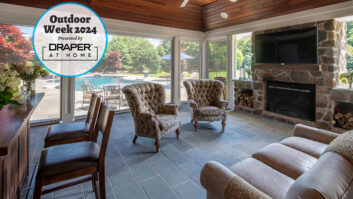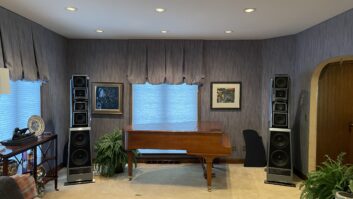It’s easy to wow clients with today’s home theater equipment. The fact that most customers are able to see, hear and touch gear prior to installation facilitates the custom installer’s task: by demonstrating the product, clients can largely witness the difference between different equipment models. They can also readily see the value in certain components.
As many custom installers know, the intangible nature of acoustical design presents an unique set of challenges to those who must emphasize to their clients the importance of properly modeling a space to achieve the best results possible. Although the consumer market is becoming increasingly savvy about technology in general, acoustics is a little more difficult to explain.
“In normal home theaters, the weakest link is by far the room,” said Keith Yates of the Keith Yates Design Group, an Auburn, California-based design, engineering and testing company focused on home theaters, media rooms, precision listening rooms and concert and recital halls. “The acoustical environment that you put the speakers in shapes the sound, or controls the quality far more than by upgrading or downgrading the speakers. It’s the match between the speakers and the acoustic environment, and the quality of the acoustic environment, that determines how good the sound is at your listening position.”
Clients can understand this better when given some relevant illustrations. Yates favors the high school band vs. Carnegie Hall scenario: “I say to the client: Imagine that your high school band is giving a concert in the gym. Of course it is going to sound like one big, echoey mess. Now, imagine that the New York Philharmonic comes to town and plays a concert in the same gym–it is still going to sound like one big, echoey mess. But if you put the high school band in Carnegie Hall, you might be surprised that they don’t sound half-bad after all. A good high school orchestra in Carnegie Hall is a better sound for the audience than the New York Philharmonic playing in a high school gym.”
Like Yates, Anthony Grimani, president and lead consultant at California-based Performance Media Industries Ltd. (PMI), a consultancy that specializes in multi-channel audio/video systems design for production, broadcast, recording and high-end consumer applications, prefers to demonstrate to clients the importance of acoustics in lieu of giving complicated lessons in physics. A former employee of Dolby and THX, Grimani uses loudspeakers to convey to clients how acoustics work.
“It is very intangible, and that’s the biggest challenge of our business right now–how to explain to people what they’re going to get out of this. I’ve used a whole bunch of different approaches. I will bring a little speaker with me and move it around the room. I’ll say–sit here, and note what happens when I approach the wall with the speaker. Notice how its sound changes when you move it around the room. Or, I’ll bring in a subwoofer and put it in a corner, and I’ll have the client walk around the room listening to one sound so they can notice how, when you move around the room, the sound changes.” Russ Herschelmann, president of Russ Herschelmann Designs in Napa, California, an acoustical design firm specializing in dedicated screening rooms and residential concert halls, finds has a more direct approach.
“There is a simple way that I have demonstrated the importance of acoustics, and it’s self-perpetuating,” he said. “You design rooms that sound better than those designed by other people. Instead of explaining all of the acoustical implications, the best example is to have a person sit in a room and hear the difference.”
The difficulty is in getting clients to acknowledge that although their ears may be untrained, they can certainly hear acoustical effects. “After those two demonstrations that I perform, without actually having to go into a lecture on acoustics–instead they just witness that there is an effect that the room has on the speakers–they are convinced,” Grimani said. “Not only can they hear it, but then they feel good that they can actually hear it. That’s half the battle: to get people to be convinced that they actually have a good ear.”
Coupled with that is the fact that many clients view acoustics as a subjective art form, rather than a legitimate science. “To a lot of people, acoustics seems like a black magic,” Grimani observed. “It’s not at all. It’s very simple, physical, and in some cases psychoacoustic events, which are the combination of physical distribution of sound in the room and how it is perceived by a human being – it’s an ear/brain phenomenon. All of those factors are fairly well understood in science today, and you can design a lot of rooms using not a lot of subjectivity, but using standard mathematics and science to come up with something that when you turn it on, it sounds good. Educated design can yield very good results, if you know what you’re doing.”
According to Frederick J. Ampel, president of the Overland Park, Kansas-based Technology Visions, a consulting firm specializing in marketing and technical services for the professional audio/video industry, a good design begins with the admission that every space is problematic, from an acoustical perspective, in some way. “Every room, especially in residential spaces, is a bad room in some way,” he said. “Most commercial spaces are built to a plan. The majority of not-built-to-order residential spaces are what is already there, and it is extremely unlikely that the builder or the designer of the home took acoustics into consideration. Unless the space was designed from the ground up with that in mind, it’s unlikely that it was considered.”
Grimani agrees. “In my experience no home theater is perfect; it’s all a set of compromises,” he said. “A good home theater is one for which the best compromises have been chosen, or the ones that affect the sound quality the least. A big part of the engineering game is figuring out what perfection is, and where you actually have to roll things back so that they impact minimally the final result.” However, the challenges associated with acoustical design for home theater versus those faced by designers in the commercial field bear little difference says Dr. Floyd E. Toole, noted engineer and corporate vice president of acoustical engineering at Harman International.
“The challenges that are present in a multi-channel system are the challenges that have been there for the 50 years that we put up with two-channel stereo,” he said. “In fact, I will go further to say that because it’s a multi-channel system, and we have more channels and more loudspeakers, the effect of the room, actually, is diminished compared to the effect of the room on a two-channel system. The customer, in general, is in a much better position with a multi-channel system than he or she ever was with a two-channel stereo. More real sources of sound in the room acoustically dilute the effects of the room itself.”
At the same time, the presence of more audio sources opens the door for problems at low frequencies. “Multi-channel audio systems differ from audio systems of the past in that a stereo system was really designed for a single listener,” Toole noted. “There really is only one seat in a room where you can hear stereo correctly. Multi-channel audio changes that rule completely. It attempts to deliver a similar kind of listening experience to an audience of several people in the room, which makes things a lot more difficult, and at low frequencies especially.”
As the instrumentation that is utilized for acoustical design progresses, Toole and others believe that the amount of information that acousticiansgather at the beginning stages of the design process will be more helpful. “There are new instruments on the market that weren’t here three years ago that give us a lot more information,” Ampel said. “It’s going to be easier to take the measurements and retrieve the data.”
Until then, acoustical designers and custom installers will continue to concentrate on the source of their audio-related predicaments: the space in which they are working.
“The room is significantly important because in general, all of the systems are good,” said Dr. Peter D’Antonio, president of RPG Diffusor Systems Inc. RPG is currently working on developing a virtual room design system, with which designers can utilize software to not only design room acoustics, but also play back how the room will sound. “The only way you can differentiate the systems is by putting them in a good room, because if you put the best system in a bad room, it’s going to be a bad system.”
Carolyn Heinze works from her media services firm in Vancouver, Canada.







